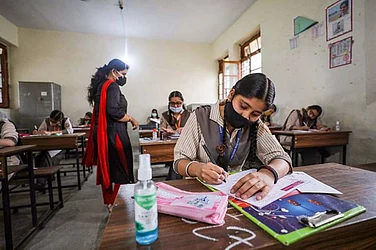Here is my key advice to smart and ambitious young people in 21st century India:
“If you are attracted to different subjects, don’t choose between them. Go for them both.”
Feeling torn between disparate subjects is the best possible thing. It is a mark of genuine liveliness and curiosity. It is such a good thing that I recommend it to everyone. To those of you who don’t feel torn between incompatible things—those who know what you love and are monogamous about it—try to cultivate a disciplinary field that is quite different from, even incompatible with your primary interest.
Contra-disciplinarity is the best model of liberal ‘art-science’ education. It is also its exciting future. Dual majors such as computer science and English, or music and computer science embody high models of contra-disciplinary education. Philosophy and physics might form a similar pair, as old as it is new, a timeless classic. Their shared interest in explaining the universe is split between the natural, the human, and the spiritual. Between concrete reality through the senses and larger patterns that appear as abstract—between experience and data on one hand, and theory on the other, both moving toward the latter through the means of mathematics—the ultimate symbolic system of abstract language.
These are tall orders. No matter how exciting. For those to whom these feel too tall, there are plenty of other options. If you truly hate and fear mathematics and have your heart set on the arts and the humanities, perhaps you could pair your specialisation with a quantitative social science. Of such social sciences, economics would be the bravest choice, as in its current form it’s not that different from mathematics. If that’s too daunting, there is sociology, which, too, makes liberal use of quantitative models, unlike, say, cultural anthropology, which, as it’s practised today, is softer, far less quantitative, more of a qualitative or imaginative social science. And the least courageous would be to combine a core humanities subject, such as literature, with history, a subject that straddles the humanities and the social sciences.

Placed next to each other, literature and the social sciences shed light on each other’s worldviews in ways that do not come to surface when studied on their own. Literature is usually imagined as the expression of a special individual—the artist who creates life and reality out of her own mind. More importantly, literature seeks to portray the private lives of individuals; its commitment is to the particular, not to the general. Social sciences on the other hand, are more interested in the general than the particular, larger patterns more than the individual stories. When they are interested in the particular or the private, it is usually as a way of understanding general or larger structures in society. They seek to throw light not on a unique man or woman, but on the greater social, cultural, economic, and historic conditions that shape such men and women.
The collective instinct of the social sciences throws into greater relief the private instinct of literature. For the student of literature, it is the invaluable reminder that even the most private of lives exist on a canvas of larger social reality; that things that we imagine as pure personal idiosyncrasy are in fact, a strange chemical compound of the personal, the familial, the cultural and the material, in mind-boggling ways that the various elements can never be separated or sifted out. It throws into similar relief the idea of the writer as a solitary figure crafting life and reality out of her own internal wellspring of genius. The writer too, is a social animal (even the unsocial ones) and a historical being, and that wild and private utterance that appears to be pure artistic idiosyncrasy is also touched by the inevitable hand of history. The social sciences are, moreover, a reminder that the writer was imagined as a far more social being in pre-modern times than in the modern age, if such a figure as the writer was imagined at all, to describe the various singing and performing poets and storytellers who strung together what we later came to call ‘literature’.
Still, these are predictable combinations between disciplines that are close to each other. So is the time-honoured combination of physics and mathematics, still an intriguing mix of abstract patterns and material reality. Mathematics delights in abstract patterns for their own sake; in physics, such patterns are used to make sense of material reality and to identify laws that govern the universe. Mathematics and the arts come together to embody this model of art-science education with greater richness—the contra-disciplinary always has a rhythm, no matter how counter-intuitive its surface. The affinity of music with basic mathematical patterns is well established.
More interesting, however, is the play of the abstract and the concrete that would define the sensibility of the student with a dual focus on mathematics and art, be it visual, performative, or literary. The visual arts might combine spatial with logical-mathematical intelligence, just as the literary arts might combine the latter with linguistic intelligence. Mathematics aspires toward the pure and the abstract; the arts, however, are defined by an eternal tension between the experiential and the theoretical, the concrete and the abstract. Without the concrete, there is no experience, and without the abstract there is no understanding. The arts must have both. A student specialising in mathematics and art will delve into the contradictory relation with the abstract and the concrete that defines the two domains, even as they experience the play of patterns, numerical or spatial, that hold the musical and the visual arts in friendship with mathematics.
These are, indeed, some of the basic axes around which the disciplines revolve: the individual and the collective, the private and the social, the abstract and the concrete. Then there is the human and the natural, which is supposed to distinguish the humanities and the social sciences from the natural sciences. Finally, there is the quantitative and the qualitative—probably the most important of these binaries: numbers or language—which of the two key symbolic systems to use, or both, and in what combination? Dual specialisations that combine a qualitative discipline with a quantitative one offer the next-generation model of art-science education. Occasionally, this also becomes a combination of inquiries into the human and the natural world. The possibilities are endless. History and biology. Chemistry and anthropology. Literature and mathematics. Statistics and linguistics.
Over and above the usual suspects: physics and philosophy, music and mathematics, and newly-established programmes such as dual majors in computer science and English, and music and computer science. They can be tailored in whatever combination works best for the student and the institution, in whatever form allowed by the curriculum, and the student’s will and capacity. The most ambitious student will go for the double major in disparate disciplines. Others may choose to major in their field of passion and minor in something far apart; or at the very least, a major and a cluster of courses in the other, enough to form a sub-specialisation.
At the heart of the double specialisation in disparate disciplines is the critical need to disrupt the provincialism of single-discipline thinking. Indeed, there is some need to disrupt disciplinary thinking itself, to de-emphasise the discipline to an extent in order to prioritise the education. Contra-disciplinarity is a liberal arts principle, since the liberal arts are less about immersion in a specific discipline (though it is about that too) and more about mastering a key set of life skills that do not come exclusively from any one discipline, or even from a neighbouring set of disciplines. A liberal art-science education involves something of an intellectual democracy where different epistemic forms, backed by the different intelligences, live and thrive in an electoral college. Like all democracies, there is a productive tension between the citizens, which keeps the pointed edges of their respective disciplinary hubris in check.

This principle shapes the general education component of liberal art-science education, which in many colleges worldwide involves sets of courses in the different methods of inquiry: humanistic, aesthetic, social, quantitative, mathematical, scientific, technological, and so on. But important as general education is, it will never get the student’s attention and energy the way their specialisation will. And for good reasons. The liberal art-science experience, after all, is not meant to be upgraded K-12—simply an energised and more complex version of the secondary school learning experience. There is a significant qualitative difference between school and college, and disciplinary specialisation is a key component of this difference.
The deepest ways of engaging with the world are best reaped from intense and sustained encounters with the disciplines. And this engagement must involve the production as well as the consumption of knowledge. The defining aspect of a student’s undergraduate experience is always their engagement with the major(s), to a lesser degree, the minor(s); it is rarely the General Education component. This is true no matter how much we wish students took this crucial component more seriously. The reality is that for every student who enjoys and engages with the general education component of the curriculum, there will be scores who will simply coast through them, quickly get them ‘out of their way’, and consequently, forget everything about them as soon as they are done with them.
The liberal art-science principle, then, must be realised within the structure, content and the texture of disciplinary specialisation itself. Sometimes a discipline is best understood when one steps away from it and tries to evaluate its place in the larger world of reality by casting it in contrast with a disparate discipline. There is, I hope, a fruitful paradox at work here. The stepping away, in the end, is also a deeper stepping in. And the deeper engagement with epistemic forms, in the end, is also a partial disengagement with content.
The best way to understand a liberal art-science education is to imagine it as an end in itself, as something on which one’s life and career can be founded without the requirement of further training and specialisation. In reality of course, a good art-science education offers an excellent foundation on which to build further edifices of professional training, should someone be so inclined, or, for that matter, that of advanced study and research specialisation in a specific discipline. The magical thing about liberal art-science education is that it does not—and cannot—assume that the student is headed in any particular direction after college; hence it does not exclude other possibilities. Within the structure of art-science education, which involves rigorous disciplinary specialisation, it is easy to assume that this is meant to be the foundation of further research specialisation. It is crucial that educators give up this assumption. This will impart that essential quality to the education without which it loses its liberal character. Too often, the only way to imagine and impart disciplinary expertise is to assume that one is preparing lifelong specialists in the field. But how does one teach specialisation to future non-specialists?
A good art-science education should be able to enrich the life of the student who will “not” pursue the subject of her specialisation after college. Such students, in fact, should shape the largest group of beneficiaries of undergraduate education. Five or 10 years out of college and in the midst of a career distant from their college specialisation, they will not remember the factual details of the discipline in which they majored, the disciplinary coverage attempted by the curriculum or the canon the syllabus tried to prop up with such urgency. But the education will be successful if the student retains an understanding of at least some of the key epistemic forms underlying the discipline.

To pick an example from my own discipline, English literature, the student working in public relations 10 years away from her English major can scarcely be expected to remember the group of poets and novelists who make up the Augustan or the Romantic period, or the details of their literary output. But the purpose of education will be served if they remember how the modern idea of individual authorship emerged around this time in a radical shift from more communal modes of artistic creativity in the past. The understanding of knowledge patterns is crucial in the business of life, as with whatever career in which the student may find herself. A historical understanding of the emergence of the author-function may help one to understand how and why people’s relationship with texts, codes and language are changing in the digital age, where communal and interactive engagement with them is becoming significant in a way it was not in the age of print.
In a liberal art-science education, the disciplines are but vehicles to learn a set of skills. Different disciplines deliver different combinations of these skills. For the student, the discipline one specialises in is not of final importance, and certainly of rather limited importance once she graduates from college. The single-discipline specialisation, embodied in the honours mode currently in vogue in most Indian universities, defines the entire undergraduate academic experience through a monochromatic preoccupation of the discipline in question. This model, at its best, remains rooted in the discipline to the degree that it misses out on the larger goals of undergraduate education.
At the same time, this also reveals another problem with many disciplines worldwide, from economics to English, and in many of the sciences, where undergraduate education is simply structured as vocational training for graduate school. If the college education can cultivate at least two intelligences—to use Howard Gardner’s Multiple Intelligence Theory—that would be a real success; especially two that have no immediate relation with each other. My education in literature, and my career as a novelist, critic, and teacher of literature has hinged on the cultivation of linguistic intelligence and the personal intelligences. Which has been a lot of fun, but I reckon it might have been even more interesting and challenging to choose a set of disciplinary specialisations that might combine the linguistic with say, spatial intelligence. The natural affinity between linguistic and personal intelligence prepares one for a certain kind of career, but the combination of the linguistic with say, the spatial intelligence, might widen the field of possibilities even more. Generally, if a disciplinary specialisation combines two (or more) intelligences far from each other, the career possibilities grow wider. The farther apart they are, the wider one’s range of careers.

Clearly, a combination of linguistic and logical-mathematical intelligence will make you the most desirable to the widest range of employers. Between the two of them, these two intelligences cover the foundations of most academic disciplines. As Gardner has pointed out, the most current and pervasive definition of the intelligent person in the 21st century is as a skilled interpreter of symbolic systems. And the two most significant symbolic systems driving human culture and civilisation today are structured by different kinds of linguistic and numerical symbols. But there are other combinations of intelligences that can prepare one for a wide range of careers. The cultivation of logical-mathematical intelligence with spatial intelligence can be a rich combination. A dual specialisation of mathematics/economics with the visual arts can achieve this. Given their mutual relationship, a combination of musical and mathematical intelligence will be disruptive and integrative at the same time, as articulated in a dual major such as music and computer science. Subjects that offer a variety of combinations between naturalist, linguistic, and logical-mathematical intelligences can prepare one for a wide range of careers in the biological, medical and pharmaceutical fields.
The key purpose of a college education is to teach participants a crucial set of skills—critical thinking, interpersonal communication, analytic skills and imaginative ability. The educationist John Dewey made the argument that the disciplines are simply different vessels through which to learn a key set of skills that prove invaluable in life—critical thinking, imagination, analytical ability, interpersonal skills, and other fundamental aptitudes. The drift in the argument was that in a genuine liberal arts education, it does not greatly matter what discipline one specialises in or what one’s major is. It is simply about the assimilation and embodiment of a core set of skills that can be done along different pathways.
But it is equally true that such skills cannot be taught in isolation, but only through the disciplines. They are like fluids that need to be poured into containers to take a temporary shape, whether that is the shape of psychology, physics, or history. The academic disciplines give us the most rigorous models of critical thinking, each in its own way. At the same time, we need to make the case for a disruptive, rather than integrative model of college education, which places disparate intelligences and epistemic modes next to each other without necessarily trying to fuse them into a single narrative. Integration, I think, frankly, is a bit overrated. We need to call for disruption rather than integration. Perhaps, at most, a weak integration at the end, in some version of a capstone project. But otherwise the disciplines will remain in a kind of a productive tension with each other. And that’s a nice and wonderful thing.
The fetishisation of a single, monolithic intelligence in existing models of the IQ and the standardised entrance test (now on their way to becoming obsolete) finds its academic counterpart in the preoccupation with a single discipline that defines the honours system still in vogue in many universities. Intelligence is now established to be pluralistic. Most of us possess more than just one kind of intelligence. The best way for college education to nourish and enrich our native intelligences is through a more fragmented model of disciplinary specialisation. Contra-disciplinary specialisation in multiple subjects will define the spirit of liberal art-science education in the 21st century.
(Views expressed are personal)
Saikat Majumdar is Professor of English & Creative Writing at Ashoka University

























